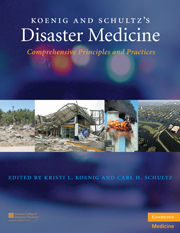Book contents
- Frontmatter
- Contents
- List of Contributors
- Contributor Biographies
- Foreword
- Preface
- Acknowledgments
- PART I CONCEPTUAL FRAMEWORK AND STRATEGIC OVERVIEW
- PART II OPERATIONAL ISSUES
- 9 Public Health and Emergency Management Systems
- 10 Legislative Authorities and Regulatory Issues
- 11 Syndromic Surveillance
- 12 Triage
- 13 Personal Protective Equipment
- 14 Decontamination
- 15 Quarantine
- 16 Mass Dispensing of Antibiotics and Vaccines
- 17 Management of Mass Gatherings
- 18 Transportation Disasters
- 19 Emergency Medical Services Scene Management
- 20 Healthcare Facility Disaster Management
- 21 Mass Fatality Management
- 22 Crisis and Emergency Risk Communication
- 23 Telemedicine and Telehealth Role in Public Health Emergencies
- 24 Complex Public Health Emergencies
- 25 Patient Identification and Tracking
- PART III CLINICAL MANAGEMENT
- Index
- Plate section
- References
11 - Syndromic Surveillance
from PART II - OPERATIONAL ISSUES
Published online by Cambridge University Press: 05 August 2011
- Frontmatter
- Contents
- List of Contributors
- Contributor Biographies
- Foreword
- Preface
- Acknowledgments
- PART I CONCEPTUAL FRAMEWORK AND STRATEGIC OVERVIEW
- PART II OPERATIONAL ISSUES
- 9 Public Health and Emergency Management Systems
- 10 Legislative Authorities and Regulatory Issues
- 11 Syndromic Surveillance
- 12 Triage
- 13 Personal Protective Equipment
- 14 Decontamination
- 15 Quarantine
- 16 Mass Dispensing of Antibiotics and Vaccines
- 17 Management of Mass Gatherings
- 18 Transportation Disasters
- 19 Emergency Medical Services Scene Management
- 20 Healthcare Facility Disaster Management
- 21 Mass Fatality Management
- 22 Crisis and Emergency Risk Communication
- 23 Telemedicine and Telehealth Role in Public Health Emergencies
- 24 Complex Public Health Emergencies
- 25 Patient Identification and Tracking
- PART III CLINICAL MANAGEMENT
- Index
- Plate section
- References
Summary
OVERVIEW
Syndromic surveillance has been defined by the U.S. Centers for Disease Control and Prevention (CDC) as “the collection and analysis of health-related data that precede diagnoses or laboratory confirmation and signal with sufficient probability a case or an outbreak for further public health response.” Based on its original definition, the purpose of syndromic surveillance would be to prevent morbidity and mortality by early identification of case clusters in which mitigation would affect the outcome of the disease's natural course. This original definition was designed for early event detection and became prominent in the public domain after the September 11, 2001 terrorist attacks in the United States and the subsequent anthrax illnesses and deaths.
With a heightened sense of urgency related to the so-called “war on terror,” many systems were put into place within the United States for the protection of the public health. These included such diverse programs as vaccine initiatives (BioShield), static detectors located throughout large cities to identify specific organisms of interest in the air (BioWatch), and the beginning of a national syndromic surveillance system for early detection of outbreaks (BioSense). These three initiatives were designed for the following reasons, respectively: 1) prevention of disease if a terrorist attack occurred; 2) early identification of airborne pathogens during the asymptomatic phase of such disease; and 3) early identification of illness prior to definitive diagnosis that would be confirmed either by culture or laboratory tests.
Keywords
- Type
- Chapter
- Information
- Koenig and Schultz's Disaster MedicineComprehensive Principles and Practices, pp. 165 - 173Publisher: Cambridge University PressPrint publication year: 2009



